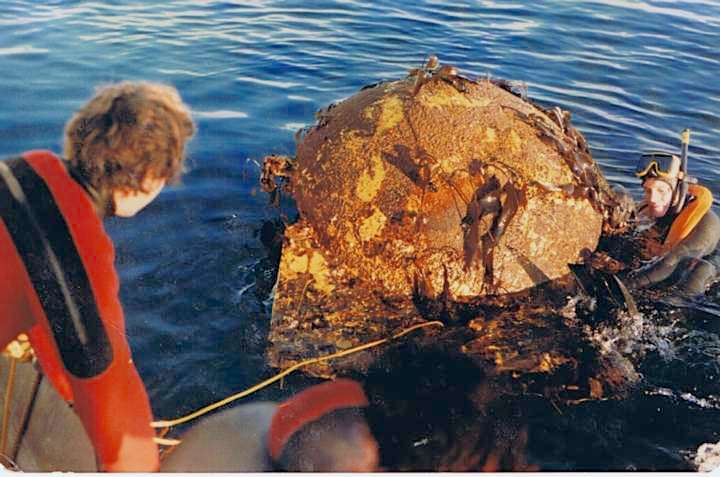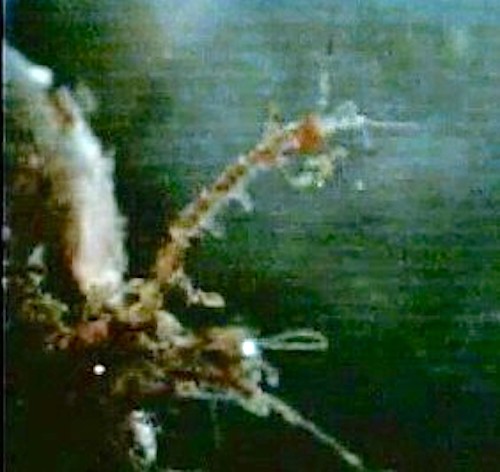We found these Caprellids at a depth of 20 metres attached to hydroids on a Balanus nubilus. They frequently dwell amongst hydroids. The size of this individual was 3mm. These individuals were photographed using a Motic Digital Microscope at 10X magnification. Note the response to stimulation when disturbed by a dull probe.

Garry and a Pearson College diver, stabilize the Institute of Ocean Sciences float before hauling it into the boat, This was at the end of one year of monitoring the tidal currents. From this process the Current Tables for Race Passage were developed by IOS.
| This Post tells the story of the Current Meter Installation :
Look closely to see these tiny skeleton shrimp clinging to the bryozoans,The shape and color help the shrimp to blend into their background. Their bodies are long, cylindrical and range from pale brown to green Some species can quickly change color to blend into their backgrounds. Skeleton shrimp look like, and sometimes are called, “praying mantises of the sea.” They have two pairs of legs attached to the front end of their bodies, with three pairs of legs at the back end. The front legs form powerful “claws” for defense, grooming and capturing food. The rear legs have strong claws that grasp and hold on to algae or other surfaces. They use their antennae for filter feeding and swimming. Diet Conservation Notes Cool Facts Shrimp, sea anemones and surf perch prey on skeleton shrimp. The females of some skeleton shrimp species kill the male after mating. Skeleton shrimp use their front legs for locomotion. To move, they grasp first with those front legs and then with their back legs, in inchworm fashion. They swim by rapidly bending and straightening their bodies. To grow, skeleton shrimp shed their old exoskeletons and form new, larger ones. They can mate only when the female is between new, hardened exoskeletons. After mating, the female deposits her eggs in a brood pouch formed from leaflike projections on the middle part of her body. Skeleton shrimp hatch directly into juvenile adults. Source: Monterey Bay Aquarium: Also see: |
Domain Eukarya
Kingdom Animalia
Phylum Arthropoda
Subphylum Crustacea
Class Malacostraca
SubclassEumalacostraca
SuperorderPeracarida
Order Amphipoda
SuborderCaprellidea
InfraorderCaprellida
Family
Genus Caprella
Species laeviuscula
Common Name: Smooth skeleton shrimp
|
Other Members of the Phylum Arthropoda at Race Rocks.
|
and Image File |
 The Race Rocks taxonomy is a collaborative venture originally started with the Biology and Environmental Systems students of Lester Pearson College UWC. It now also has contributions added by Faculty, Staff, Volunteers and Observers on the remote control webcams. March 15 2005- Kevin Mwenda- Pearson College Year 31. The Race Rocks taxonomy is a collaborative venture originally started with the Biology and Environmental Systems students of Lester Pearson College UWC. It now also has contributions added by Faculty, Staff, Volunteers and Observers on the remote control webcams. March 15 2005- Kevin Mwenda- Pearson College Year 31. |

